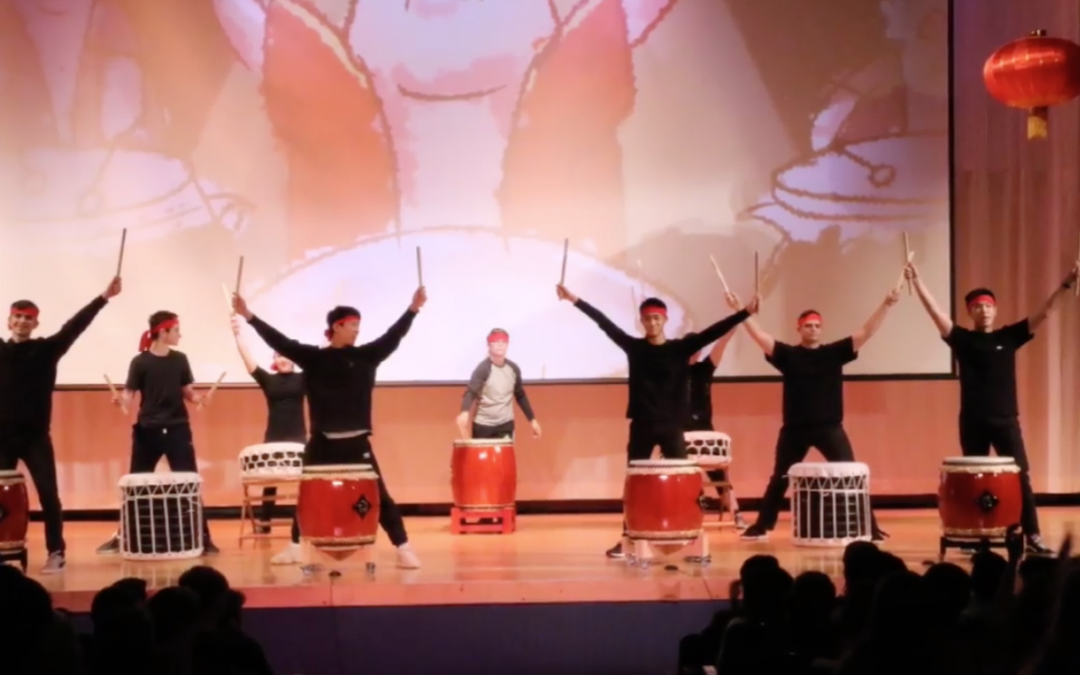
Mar 24, 2019 | School News
By Rhea Kapur ’21
On February 8th, the highly anticipated Lunar New Year Assembly opened with a bright, lively rendition of the traditional dragon dance. This was performed by students from the Form II Chinese class with taiko drumming by Mr. Christopher Leone in the background. During this standard component of festive Chinese celebrations, students maneuvered a long dragon figure using poles positioned throughout the body to simulate the “river spirit,” which the dragon represents. Dragons also symbolize Chinese culture and are thought to bring good luck for the new year.
The 2019 Lunar New Year began on February 5th and ended on the 19th. As per the zodiac calendar, 2019 is the Year of the Pig – the 12th animal in the 12-year cycle of Chinese zodiac signs. In China, pigs generally symbolize wealth. Those born in the Year of the Pig are thought to be blessed with good fortune, happiness, and success later in life.
First, and a definite highlight from this year’s assembly, were 12 exchange students from Quzhou No. 2 High School, Pingry’s sister school in southeastern China. The students, who visited Pingry for 2 weeks and were hosted by the families of various Upper School students, first introduced themselves to the school and then proceeded to sing songs they had prepared that reflected the spirit of their city and school.
Next, the brother-and-sister dynamic duo, Elbert Ho (Grade 6) on piano and Felicia Ho (VI) on violin, performed a duet of the traditional Chinese folk song “The Joy of Spring” to welcome in the spring, all while dressed in traditional Chinese clothing. Belinda Poh (III), Francesca Rainuzzo (IV), Udochi Emeghara (VI), and Annaya Baynes (VI), members of the K-Pop Dance club, followed with another energetic, more modern performance of “DDU-DU DDU-DU” by the K-Pop girl group Black Pink.
The Taiko Drumming Club introduced a new performance piece, “Dokokara,” during the assembly, featuring solos by Noah Bergam (IV), Julian Lee (IV), Justin Li (IV), and Guan Liang (IV). This year’s piece was “one of the hardest yet, especially in terms of technique” said Lee, “with many complicated elements that involved interaction between us four soloists – we had to pass the beat back and forth.” Next was The Purple Swans Dance Troupe, a group focused on displaying the beauty, ideas, and significance behind Chinese culture through peking opera, which combines opera with dancing, acting, and acrobatics. Many members of the Pingry community belong to this group, and some took part in their dance performance during the assembly, titled, “The Song of the Pear Blossom.”
New additions to the 2019 assembly included Natalie DeVito (III)’s recital of the poem “Facing the Sea by the Warmth of Spring” by the famous poet Hai Zi entirely in Chinese. The closing element, an exclusive interview with Pingry Sage Dining Executive Chef Mr. Won Ho, a Chinese immigrant, and James Wang (V) was also a highlight. Overall, the many diverse performances of this year’s Lunar New Year Assembly emphasized the beauty of Chinese culture and its core virtues, something to remember and look back on for the year to come.
Jan 19, 2019 | Noah Bergam, School News
By Noah Bergam ’21
Once meant as a method to curb nicotine addiction, vaping has become an increasingly widespread practice among American youth. As the number of vaping high school students across the country rises, it has become ever more important for teens, as well as parents, to understand the health risks of the practice.
For all their flavors and attention in the media, vaping devices, also known as e-cigarettes or e-vaporizers, have had their share of controversy among Pingry’s own community in recent years. As such, all of Pingry’s health classes have already made sure to include important information about the relatively new trend in their curricula. However, until now, parents have mostly been left out of the loop. In response, the Health Department put on an informative health and wellness presentation for parents for the first time about the issue on November 28th.
Led by health teacher Mrs. Nancy Romano and Health Department Chair Mrs. Susan Marotto, the presentation was a response to a request from a number of Pingry parents who wanted to know more about the consequences of vaping devices.
“We wanted to run the meeting to tell parents about some of the risks of vaping,” said Mrs. Marotto. “We wanted to give them information about what vaping devices are, some of the dangers involved, and how they can talk to their children about it.”
Real vaping devices were on display for parents throughout the 75-minute presentation. Overall, it was a very informative night for the community.
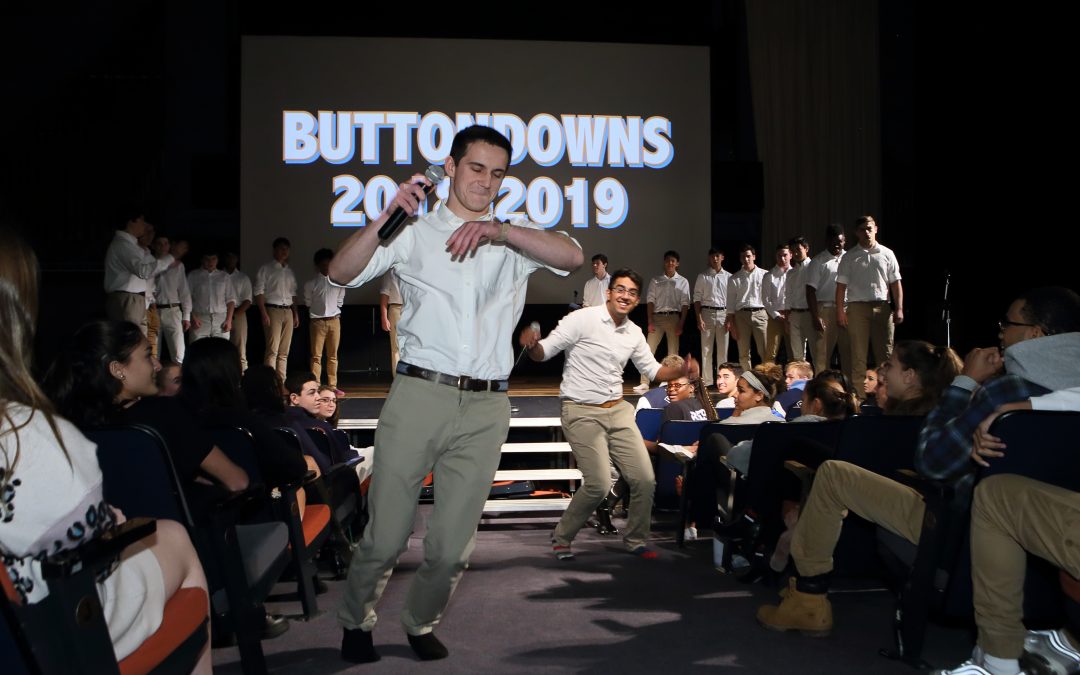
Jan 18, 2019 | School News
By Monica Chan ’21
On November 20th, the final day before the start of Thanksgiving break, the Buttondowns serenaded the Upper School in Hauser Auditorium at their annual Buttondowns Assembly. The elite boys’ acapella group is led this year by president Rajeev Doraswamy (VI) and vice president Ian Dugan (VI).
The assembly began with the highly anticipated Buttondowns movie, an annual tradition. The three-movie format was inspired by “Edgar Wright’s unofficial ‘Cornetto Trilogy,’ a film trilogy with the same actors, themes, and creative team,” according to Dugan.
The seniors in the Buttondowns had been planning the movie for a long time, as evidenced by clips of the seniors throughout the years. To this, Dugan elaborated, “The introduction to the film was written back when we filmed in the BAC construction site as freshmen, and we left it open ended as to be able to take whatever creative direction we wanted.”
At the end of the movie, the Buttondowns ran down the flight of stairs to the stage wearing their namesake white button down shirts, khakis, and of course, no shoes. The first song was Bruno Mars’ “Marry You” with soloists John Robertson (V), Ore Shote (IV), and Alex Kaplan (IV). “I always learn something from performing in front of crowds. In this case, I learned how to lend attention to the people behind me while still singing correctly,” Kaplan reflected.
The next song had a more R&B feel: “Juke Jam” by Chance the Rapper, with soloists James Wang (V) and Nolan Baynes (IV). This is the second year the two have paired up for a song at the annual assembly. Baynes said he enjoys performing with Wang because, “I think that chemistry between us shows when we sing together, which is really unique.”
Nabeel Jan (VI) and Dugan sang next with the 1980’s hit “Jessie’s Girl” by Rick Springfield. Jan mentioned that he really enjoyed performing this particular song as both he and Charlie Malone (V) arranged the music together.
Finally, Rajeev Doraswamy (VI) and Henry Wood (IV) sang the closing song, George Erza’s “Budapest.” Wood appreciated how the song’s lyrics, “generally talk about how love is more important than anything else.”
Doraswamy spoke after the assembly about his years in the Buttondowns group, reflecting that, “It hadn’t hit me that it was my last assembly until it was over; once it did end, I felt a huge sense of gratitude to those who put countless hours in, and definitely some sadness that it was my last one.” He thanked Dr. Andrew Moore, “who was there for me all four years and has never wavered in his support for the group.” Doraswamy also thanked his fellow seniors Dugan, Jan, Thomas Campbell, and Ryan Henriques, as well as the entire class of 2019, “who have cheered us on from freshman year until now.” He also thanked Dugan for the immense effort he put into the Buttondowns movie.
The event was widely enjoyed by the whole Upper School, apparent by the loud applause. As a final note, Doraswamy said, “All in all, I’m really proud of the boys, and I’ll definitely be looking back on it with a real sense of both happiness and sadness.”
Jan 15, 2019 | School News
By Vicky Gu ’20
On November 14, Pingry’s advanced Upper School visual arts students took their annual field trip to the Chelsea neighborhood of New York City. There, they visited many diverse art galleries, each displaying various media, such as paints, prints, sculptures, films, photographs, and other installation-type pieces. Because the art shown in the galleries is constantly changing, the students have a chance to become inspired by and learn from the trip each year even if they are visiting the same locations.
Students were split up into rough groups based on the art class they are enrolled in, so as not to overcrowd any one particular gallery at a time. Though they visited many of the same galleries, some groups viewed galleries tailored to their classes that others did not. For example, a group of junior and senior photographers visited the David Zwirner Gallery, which showed small, figurative paintings by Lisa Yuskavage. Other places students visited included the Albertz Benda, James Cohan, Agora, Asya Geisberg, and Mary Boone galleries.
Reactions to the artists’ works varied from admiration to surprise, from confusion to quiet contemplation. When visiting the Gagosian Gallery, the students examined the very messily linear works of Mark Grotjahn. “It looked like swathes of toothpaste were put on it. Tubes of white toothpaste with green and red stripes in it,” said Victoria Gu (V). Another classmate noticed that one of the swatches had fallen off, leaving behind a pale, white imprint. Many quickly dismissed it as another incomprehensible example of contemporary art and gathered in the gallery’s atrium to be led to the next one. Ms. Rebecca Sullivan, who teaches both the drawing and painting and film classes, then revealed some confusing and controversial news: each one of the 75 by 60-inch paintings was worth at least $5 million dollars. The larger ones were worth closer to $10 million. In awe, the group filed back into the gallery to reexamine the paintings, wondering how they could be worth more than several houses.
One of the last galleries the groups visited was the HG Contemporary Gallery, featuring artist Susan J. Barron. Her exhibition, titled “Depicting the Invisible,” is a series of portraits of veterans suffering from PTSD surrounded by quotes about their wishes and laments. All observers were silent as they read her pieces. Many students cited that exhibition in their subsequent reflections as one of the most moving and eye-opening things they saw on the trip.
The student artists visited nearly a dozen galleries before boarding the bus for lunch. Rather than bagged lunches, students enjoyed exploring the diverse options of Chelsea Market. The previous year, the field trip had brought the students to lunch in Little Italy, and most students agreed that while Chelsea Market had fewer formal dining options, the change was welcomed because it was much less crowded.
Overall, even though the trip featured some of the same places as last year, the artists and works within the galleries had changed and the students were able to learn new things from the experience. They also got to witness the artists’ new inspirations and further survey the present-day artistic landscape.
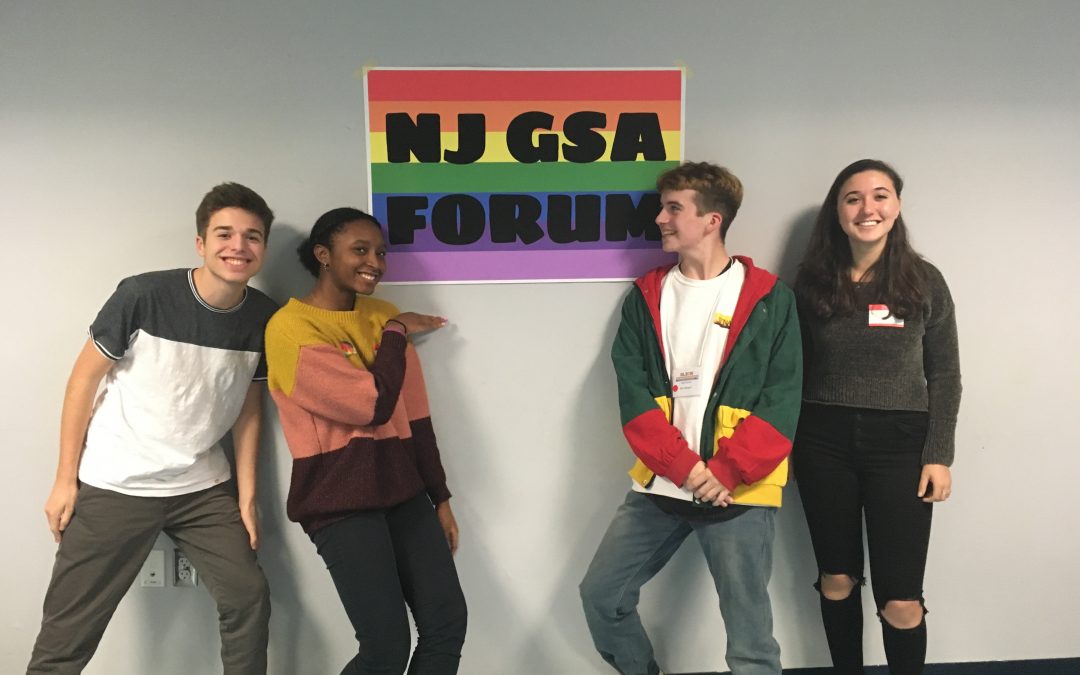
Jan 15, 2019 | School News
By Hannah Guglin ’20
On Saturday, November 17th, Pingry’s GSA (Gay-Straight Alliance) travelled to Middletown High School South to attend the 2018 New Jersey GSA Forum. The GSA Forum is an annual gathering of GSAs across the state to discuss LGBTQ+ issues. The forum allows members and allies of the LGBTQ+ community to come together.
This year, the conference began with a speech from keynote speaker Gavin Grimm. Grimm, a transgender rights activist, is currently involved in a legal case involving transgender bathroom laws after he was rejected from using the bathroom of his choice at his local school. During his speech, Grimm discussed the court case and also his process of coming out and his resilience throughout those experiences. Ethan Malzberg (VI) recalls that, “hearing the legal aspects of his story was super interesting, but also having the opportunity to hear the emotional battles he had to go through for recognition within his own family was even more enlightening.”
After the speech, there were three workshops. The workshops included, “Language Matters: The big impact of ‘little’ things,” where students discussed the impact of microaggressions and the importance of language, as well as, “Make it happen at your school: GLSEN Days of Action,” in which they talked about how to implement ideas, such as Ally Week or Day of Silence, into schools. At Pingry, the Day of Silence is observed within the community. On this day, students proceed without speaking to show solidarity for LGBTQ+ issues.
When discussing her experience at the forum, Ms. Stephanie Mygas said, “It’s nice to be able to see groups of students who are so civically engaged getting together. It was also nice to see other teachers that are involved in GSAs and hear from the community about what’s happening outside of Pingry.”
At the forum, many resources were given to those who attended. Upon arrival, folders containing a list of the different resources specific to the LGBTQ+ community were handed out. This list included ones for education and advocacy; youth groups and resource centers; parent and family support groups; and more. These provide aid not only to those looking to become more involved in the community but also to those struggling through their journey as a member.
Overall, the forum was informative and demonstrated the ability for a community to unite behind a common cause.
Jan 15, 2019 | School News
By Alex Kaplan ’21
On November 8th, the Jewish Affinity Group hosted a town hall in the wake of the mass shooting at the Tree of Life Synagogue in Pittsburgh, Pennsylvania. Eleven people were killed, making it the deadliest attack on Jews in the United States. While the event was hosted by the Jewish Affinity Group, it was open to the entire Pingry community, regardless of faith or culture. The event intended to create a space that was free for respectful debate so anyone could voice their thoughts without fear of retaliation or judgement. According to Ethan Malzberg (VI), co-facilitator of the Jewish Affinity Group, “any shooting inherently provokes a political response from some people, and we wanted to allow people to be political without turning what’s meant to be an emotional place into an argumentative place.” The town hall was a success, with high turnout and a great impact on those who attended.
Present at the town hall was Dr. Diana Artis, Chair of the Department of Diversity and Inclusion, Mrs. Eva Ostrowsky, counselor and Peer Leadership Program Advisor, and Ms. Shelley Hartz, Director of Community and Civic Engagement, as well as a number of faculty, students, and staff. Many people came both to share and to listen. Ms. Hartz felt that the town hall was a powerful experience, saying that “seeing the students [who] came to the meeting was most impactful since these were students I don’t normally see in Affinity Group meetings.”
The viewpoints that were shared varied as well. Some shared their opinions on the recent events, whereas other shared ideas they found had affected them. Mrs. Ostrowsky, for example, shared a poem written to the baby whose naming was supposed to take place during the tragedy at the synagogue. It was an emotional moment for all who attended. Malzberg noted another affective moment, saying, “I was the first person to share, so seeing people around me stand up after me was really affirming and inspiring to everyone.” Ms. Hartz and Malzberg both noted that the community turnout was better than expected.
The high attendance and heartfelt response to the event opens the door to more events of a similar nature in the future. Ms. Hartz echoed this sentiment, noting that she hopes, “as a community we can continue to find venues where students can support each other during difficult times.”
Jan 13, 2019 | School News
By Nicole Kloss ’19
German Club consists of a group of Pingry students who are eager to learn more about German culture and language. During meetings, we discuss German traditions and holidays while enjoying traditional German food. We also learn a few German words relating to the holiday.
Some club meetings include Oktoberfest, Weihnachten (Christmas), movie night, and Fasching (Spring Fest). During Oktoberfest we enjoy bratwurst, pretzels, nutella, and apfelstrudel. For Weihnachten, we make gingerbread houses and listen to Christmas music. During movie nights, we watch German movies. For Fasching we enjoy German desserts. Each meeting also comprises a presentation about each holiday detailing the history, how it is currently celebrated, and my experience with the holiday as the president of the club.
Our German Club outing for the month of December was a trip to a Christmas market in Sparta, NJ. The trip was a great opportunity for club members to fully immerse in German culture and have a deeper connection to what I talk about during club meetings. The market is on a long boardwalk beside a lake. When we first arrived, we immediately noticed the enticing smells coming from all the food vendors as well as from pine trees decorating the market.
We headed over to a biergarten area where we had delicious Bratwurst and Heisse Schokolade (hot chocolate). Then, as a club, we walked around passing vendors that sold Christmas decorations, popcorn, clothes, German snacks, and much more. As we walked, we all snacked on some stroopwafels while Christmas songs played. There was even a wood carving area where someone was making intricate wood sculptures with an electric saw.
I began German club because I am very connected to my German heritage and visit Germany often. I wanted to share my culture with the Pingry community. It is important to note that the club is welcome to everyone, regardless of whether you take German or know anything about Germany.
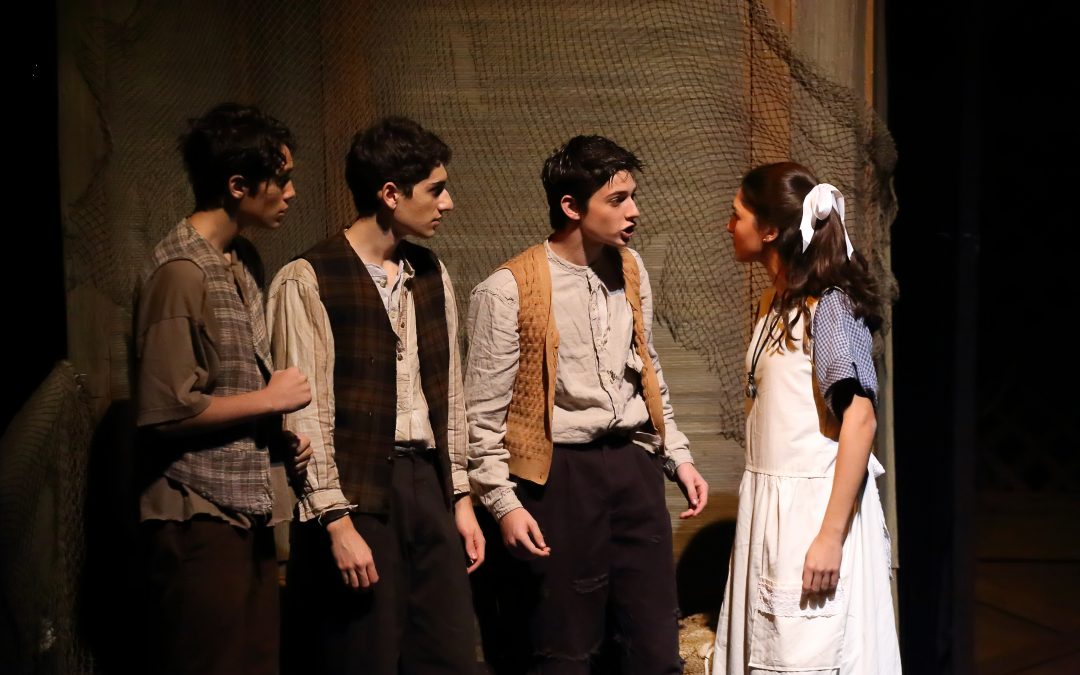
Jan 13, 2019 | Emma Drzala, School News
By Sarah Kloss ’22 and Emma Drzala ’22
Peter and the Starcatcher is a tribute to an orphan boy’s journey to discover his identity as the now well-known Peter Pan. Peter and two other orphans find themselves on a ship known as the Neverland. Soon, a girl named Molly Aster approaches them and tells them about a secret mission that only she can fulfill. This mission leads us through several adventures that greatly influence Peter’s journey to becoming Peter Pan.
The show delivered in many unexpected ways; everything from the costumes to the lighting made the show incredibly professional. Although the cast and crew were only high-schoolers, the story they told transported the audience to another world. We embarked on an adventure with the characters, allowing our minds to reach new limits.
Although the entire cast contributed to the making of this phonomenal play, Jack Lyons (VI) stole the show. He played the Black Stache, an evil pirate with a thirst for power. With his English accent, black mustache, and great acting, he kept the audience members sitting on the edge of their seats. Lyons gave a consistently wonderful performance, and, given his character, it must have been quite a challenge.
Katerina Deliargyris’ (VI) portrayal of Molly the Starcatcher could not have been more spot on, and she enchanted us with her voice at the end of Act I. Molly taught the audience passion, love, and leadership. Deliargyris embodied the character, always impressing us.
Another character who made a great impact on the audience was Prentiss, played by Andrew Cowen (VI). Cowen never failed to add a little humor even in the most serious scenes. From his snarky comments about leadership to his shouts while running through the jungle, he made every scene memorable. Indeed, Cowen was able to switch personas in the blink of an eye. One moment we would see the cocky, arrogant boy who justs wants to be the leader, and another moment we would see the scared, broken orphan who justs wants affection. This ability added depth to Cowen’s character that wouldn’t have been obvious otherwise.
The only actor that performed two lead roles was Lucas Vazquez (VI). Not only did he perform two roles, but his phenomenal acting allowed the audience to tell the two apart. His first role was Bill Slank, the ruthless pirate who takes the trunk meant for the Wasp. Vazquez delivered a classic “bad guy” character in this role. Bill Slank’s anxiety, nervousness, and evil behavior was hilariously portrayed by Vazquez.
Of course, we must not forget the boy himself, Peter Pan. Nicholas Grimaldi (VI) showed the audience the true Peter, and the story behind why he is forever young. Although Grimaldi is a senior, he was able to perfectly capture the innocence of a 13-year-old boy. He took the audience through quite a journey, and they clearly recognized his character development, one that only a true actor could pull off.
The show was incredible, as it unravelled a tale of how Peter Pan the orphan came to be the boy who is forever young. Pingry Drama has pulled off yet another spectacular performance, and we cannot wait to see the next production.
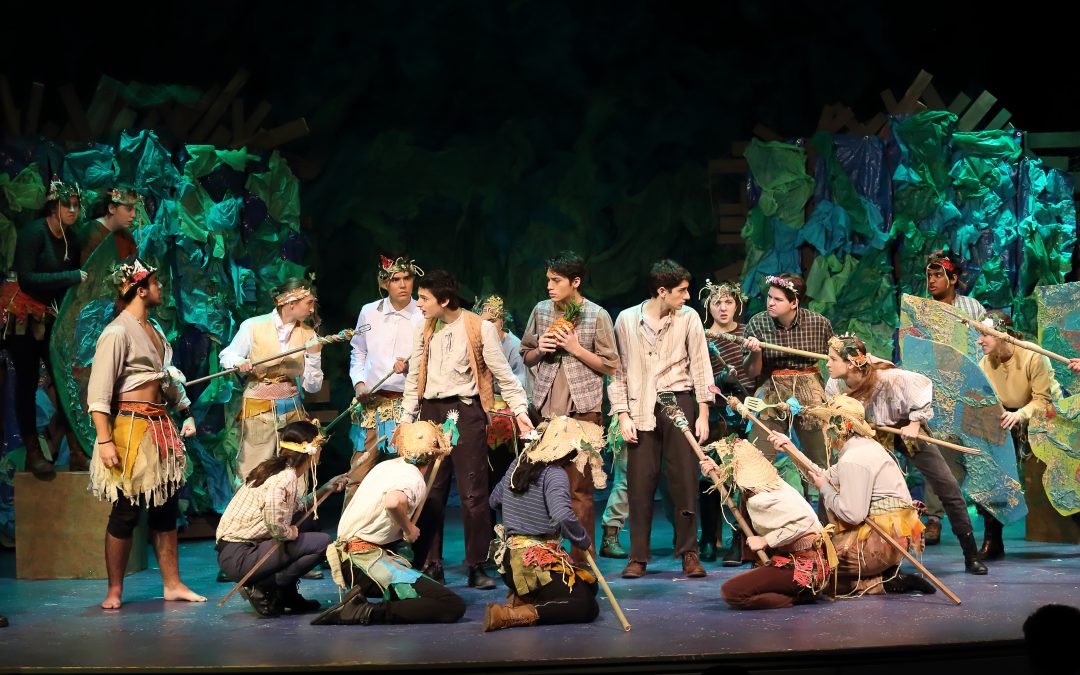
Jan 13, 2019 | School News
By Brian Li ’22
On November 8, 9, and 10, the Upper School Drama Department presented its annual fall play; this year’s play was Peter and the Starcatcher by Rick Elice. Based on the novel by Dave Barry and Ridley Pearson, this comedy explores the backstory of Peter Pan. Directed by Mrs. Stephanie Romankow, Peter and the Starcatcher included over 40 cast members, two British ships, and a forested island full of native people.
The play begins with Molly (Katerina Deliargyris, VI) and three orphans boarding the Neverland, a British ship commanded by Bill Slank (Lucas Vazquez, VI). Her father, Lord Leonard Aster (Stuart Clark, V), boards a second ship, the Wasp. Each ship has its own trunk, one filled with sand, the other with starstuff, a magical substance that makes people what they wish to be. While Molly befriends the orphans, Black Stache (Jack Lyons, VI) and his band of pirates take over the Wasp in search of the starstuff. They leave thinking they have successfully stolen the starstuff, but when they find their trunk is filled with sand, they realize the trunks had been swapped. The Wasp pursues the Neverland, while Peter (Nicholas Grimaldi, VI) and the other orphans take the starstuff and float to an island as the Neverland breaks apart. Molly finds them, but they are captured by the natives and their king, Fighting Prawn (Lucas Vazquez, VI). The orphans manage to escape with the trunk of starstuff, but Peter falls into a starstuff-filled lake. The pirates capture Molly and the two orphans, but Peter returns and interrupts the standoff. Stache opens the orphans’ trunk only to find it empty. Realizing his plan has failed, Stache gives a farewell, noting that he and his enemy Peter will meet again. Although Molly wants to take the orphans back to England, her father realizes that Peter was affected by the starstuff and cannot go back. Peter is then permanently a boy, the one thing he always wanted to be.
Although Mrs. Romankow has directed productions before, this was her first time directing the play. As a “magical” production, Mrs. Romankow said, “it embraces theater in its purest form, allowing the audience to see how the magic is made.” She appreciates that the actors are “not only a group of insanely talented students, but also students who know the importance of collaboration.”
Mr. Christopher Abbott designed and built the set, and Mr. Alan Van Antwerp served as the lighting operator. Mr. Jay Winston was the sound director, while Mary Kovacs (VI), Udochi Emeghara (VI), Grace Brown (VI), and Sonia Talarek (V) were stage managers.
This year’s fall play was drastically different from that of previous years, according to Lucas Vazquez (VI). “Last year, Antigone was an ancient Greek play with barely any movement or set changes. The cast this year was much bigger than last year’s, and we also had the songs [and] audio cues. [With] all the set changes, costume changes, and cues, it felt like we were doing a musical, or half a musical.”
The cast, along with Mrs. Romankow, agreed that the fall play was a rewarding experience. In the words of Leo Zhu (VI), “This play embodied the idea that everyone matters…I really enjoyed working with the cast and I wish I could stay at Pingry longer. It’s sad having to leave everybody behind after spending so much time with them.”
Vazquez elaborated, saying, “While I plan to do theater in college, it won’t be the same without the people I’ve known for so long. It won’t be worse, but it just won’t be the same.”

Jan 13, 2019 | School News
By Justin Li ’21
SAC has become a popular part of the Pingry community in the eyes of students and teachers alike. Students know that SAC assemblies are a perfect time to take a break and have a laugh with friends, regardless of the academic pressures during the normal school day. Under the new leadership of Ian Dugan (VI), Jack Gambello (VI), and Jack Timko (VI), the group already has a notably successful fall assembly under their belt.
We enjoy the products of SAC in the form of their comedy and performances, but how exactly does their work come to fruition? I talked to Ian Dugan about what exactly goes into an SAC assembly and how the club functions as a whole.
The preparation for an assembly usually begins with a meeting a month prior. The core team convenes, throws ideas on a whiteboard, and narrows the pool of ideas down to those that they like the most. They then assign three or four SAC members to each idea and give them a deadline to bring the idea to life. In regards to these assignments, Dugan says, “We delegate ideas to people who we think will treat them well. We’ll also have one production person with each group to make sure it’s a quality piece of art.”
After ideas are assigned, the project groups start to write, film, edit, and complete whatever else their segment entails, making sure to report back to the leaders regularly to ensure that progress is smooth and on schedule. They usually do not meet as a group again until the week of the assembly, at which point they’ll run through the script a few times. Before any joke hits the stage, it must be approved by Dean Ross and any of the students or teachers at which the joke is aimed.
This process has evidently worked well for SAC, as they have received particularly positive reception for their latest assembly. Dugan remarked, “I had teachers email me and say that it was the funniest SAC assembly that they’ve been to, and I really appreciate that because it makes me feel like we were successful. Overall, it’s been positive feedback about the assembly. When comments about the assembly are as specific as: ‘I think this idea went on for a little too long,’ or ‘I didn’t like this one joke,’ then that means as a whole, it was a good assembly.”
A large reason behind the quality of SAC’s events lies in the diversity of their ranks; their jokes must appeal to the entire audience, rather than a select few. Dugan and the rest of leaders have made it an effort to make sure that students from all over the school have a voice in the club. This school year, they’ve achieved the most equal gender ratio in recent memory and have increased the number of sophomore and junior members by a sizable measure as well. Dugan said, “Generally, SAC has been one group of friends making jokes for their group of friends, but this year, we’ve tried to find the funniest people in different social groups who may have not been included in SAC in previous years.” The Meme of the Week has also doubled as a way to find out “who’s funny, who has potential, and who we want on SAC.”
SAC’s process of taking on new members is also unlike that of most other clubs at Pingry. There is no sign-up sheet or application where you present your most guffaw-inducing jokes; instead, it is up to the leaders to decide who deserves a spot on the team. During the summer, they meet and compile a list of candidates who they think would be great additions to the team and reach out to them when school starts. In some rare cases, students who demonstrate persistent interest may also be considered and admitted into the group. This method of selecting new members is one reason why SAC has been successful.
The next thing we can look forward to from SAC is their annual winter assembly, which the team has not yet begun preparing. The winter assembly, held in the senior commons, distinguishes itself from its fall counterpart in that is entirely live, a factor that makes Ian describes as a “challenge” and “a whole different territory” for the group. However, he also sees it as “another opportunity to diversify by getting Pingry’s actors and actresses on board.” It is evident that even with the changes the club has made this year, they have remained true to the spirit of SAC that the Pingry community has loved. All in all, there is a lot more behind their jokes than it may seem.






